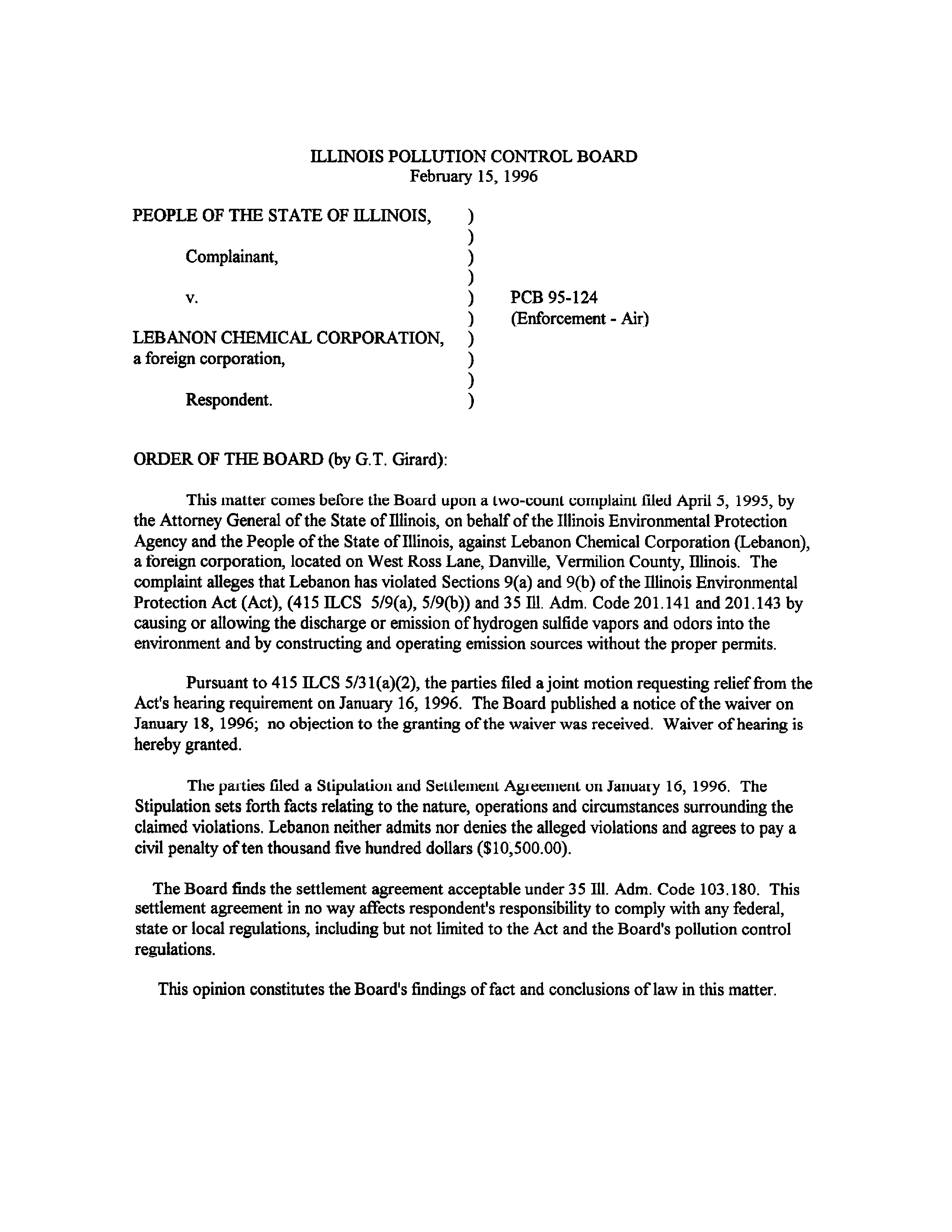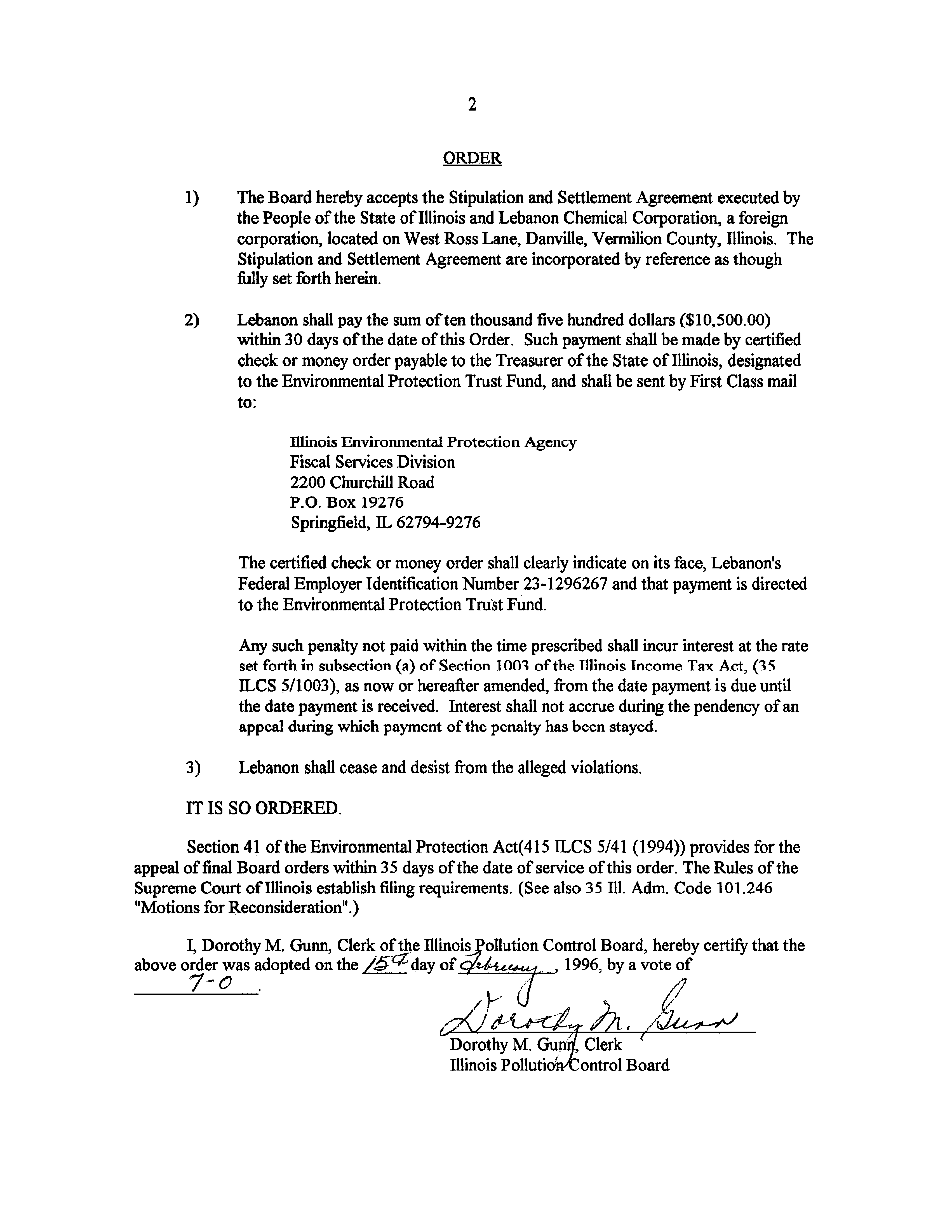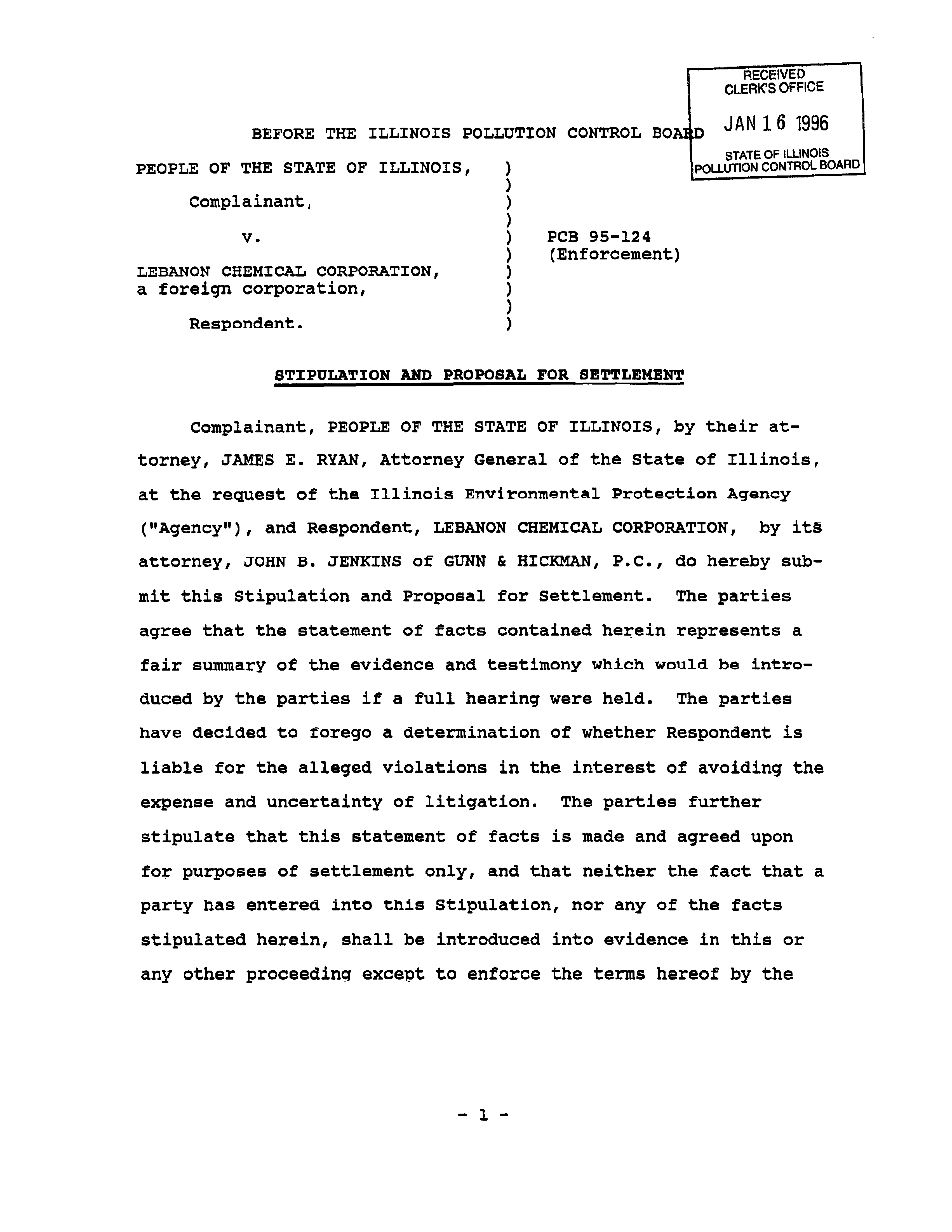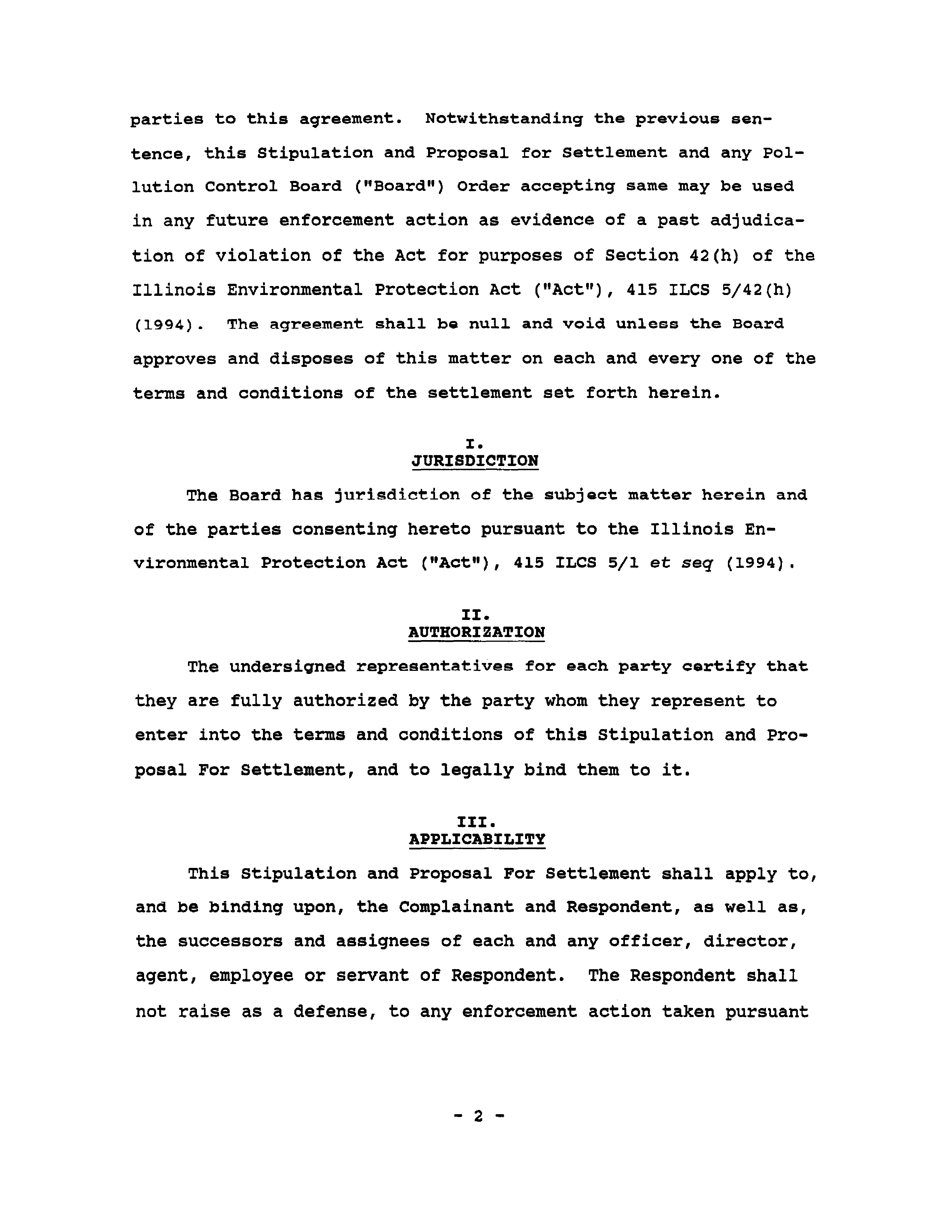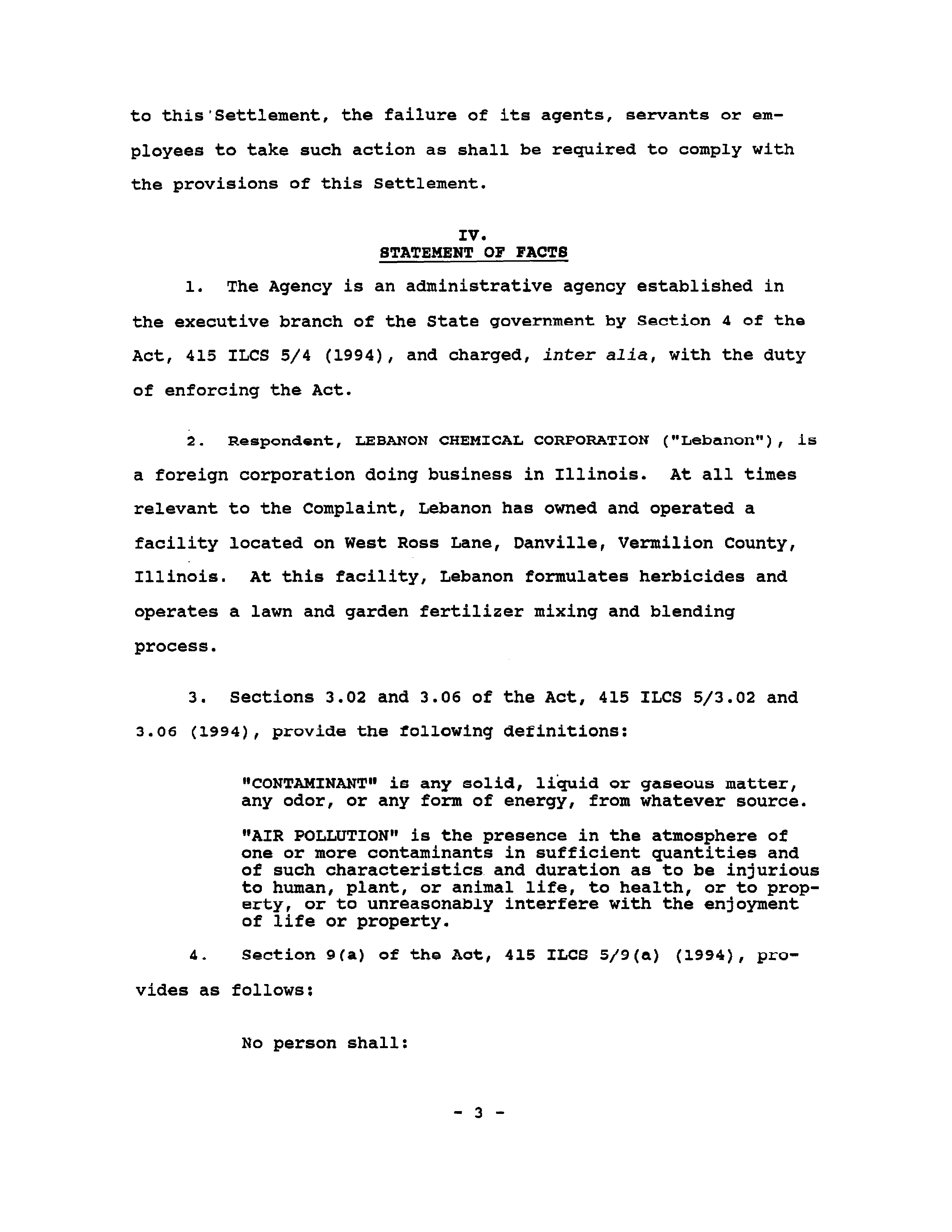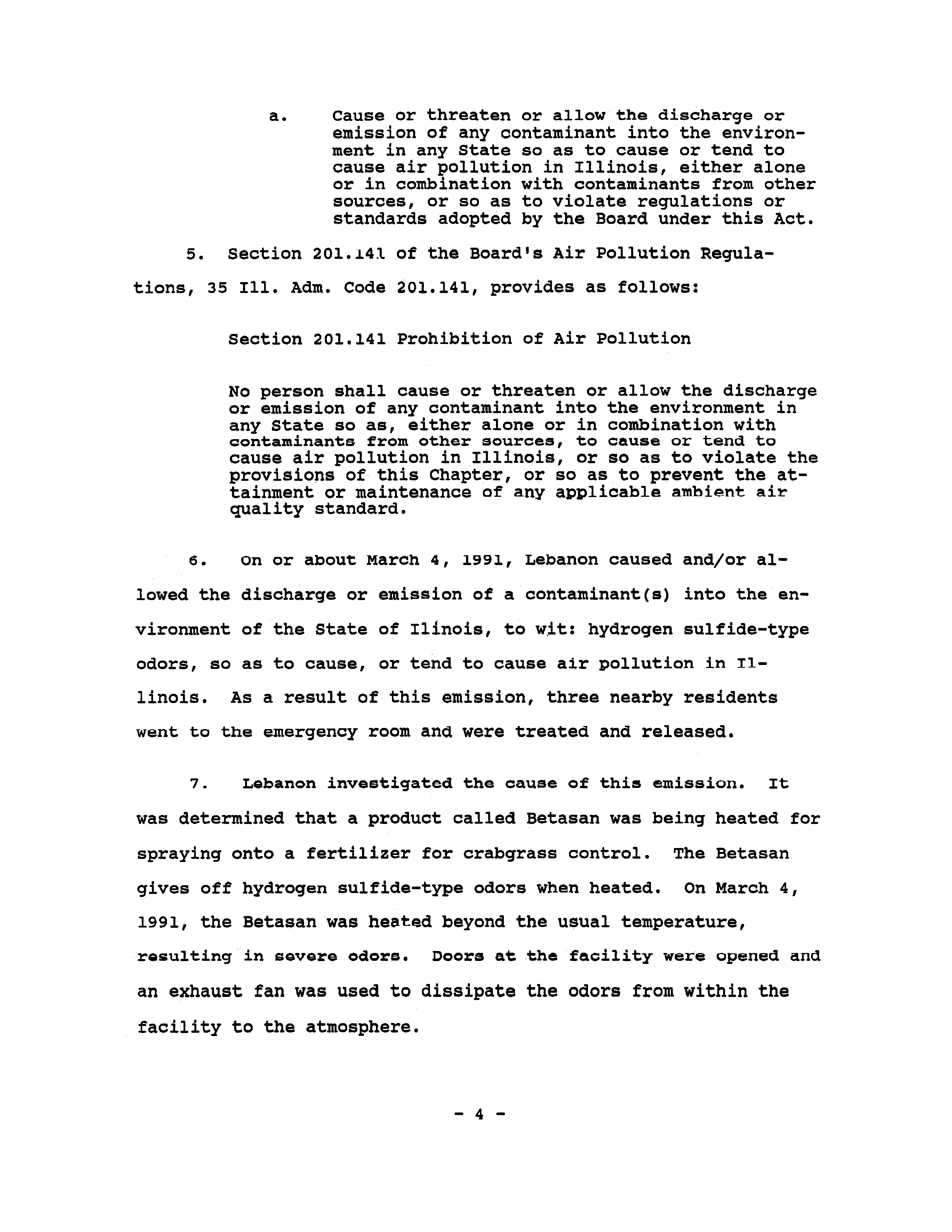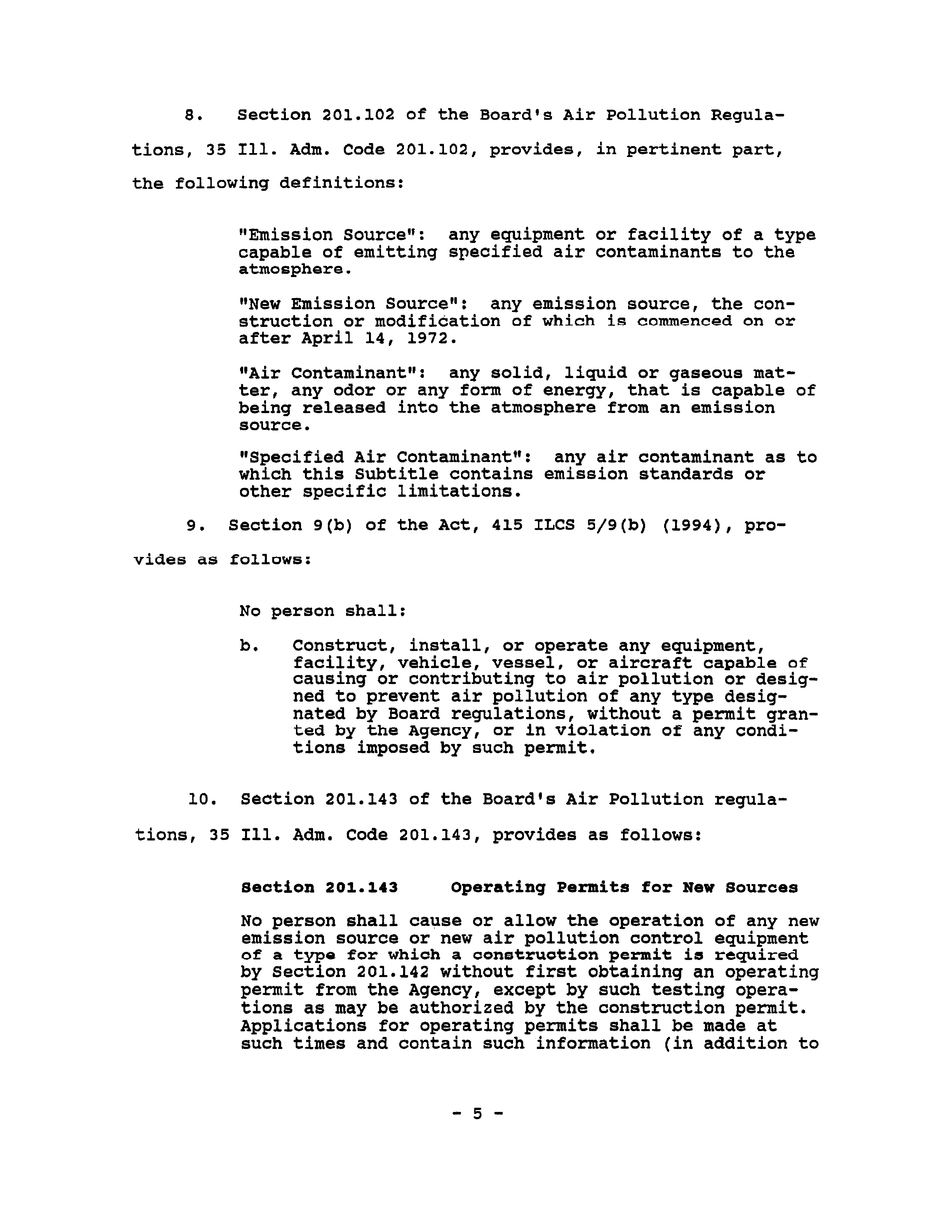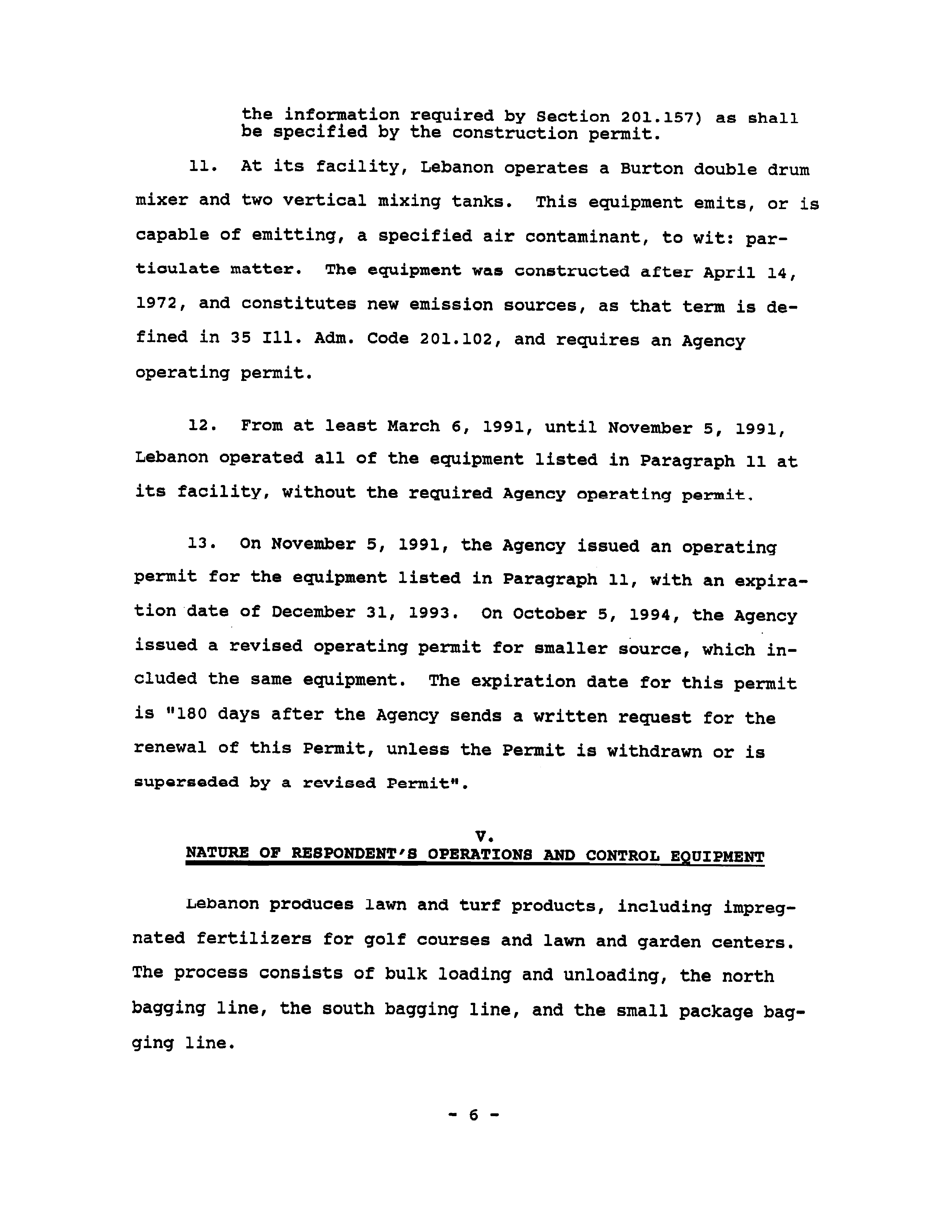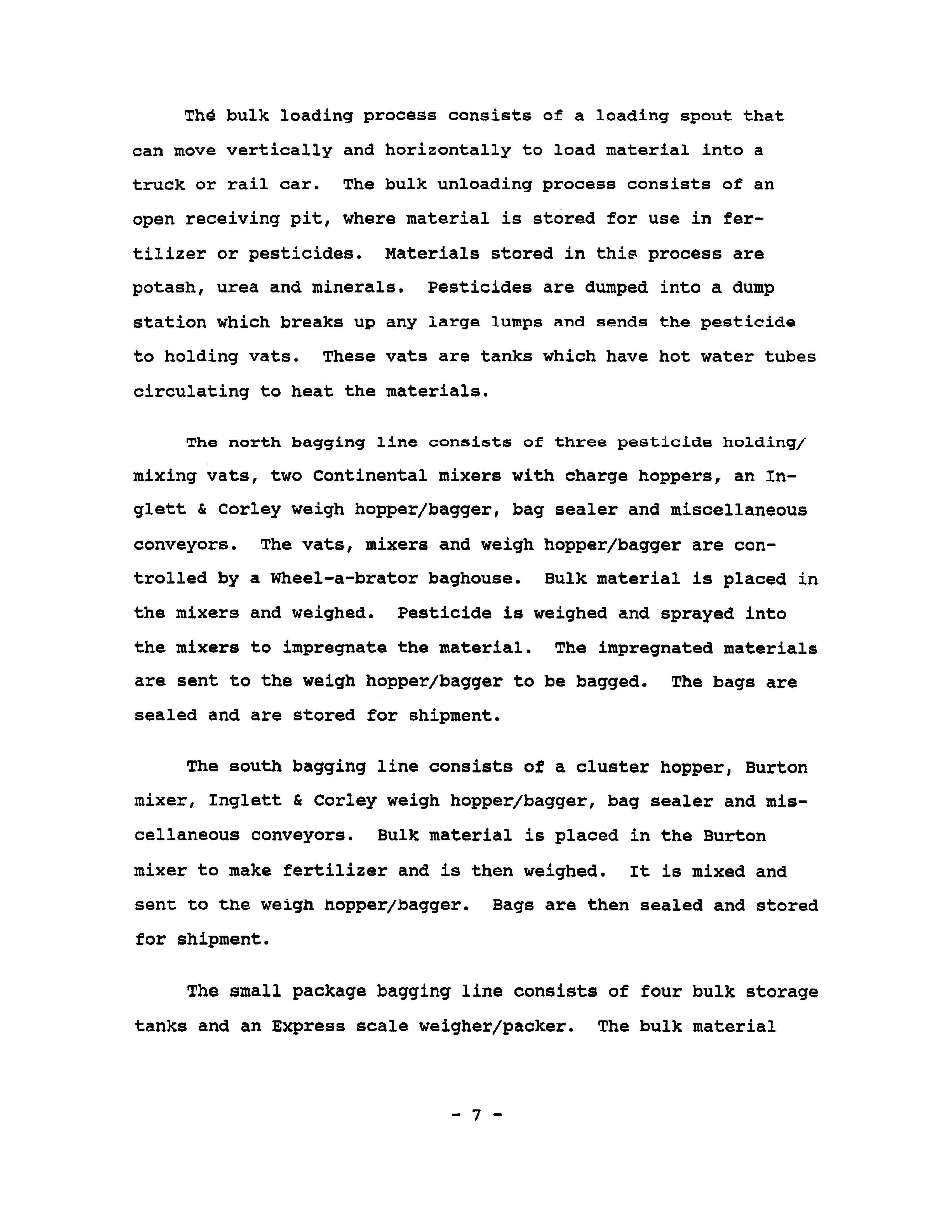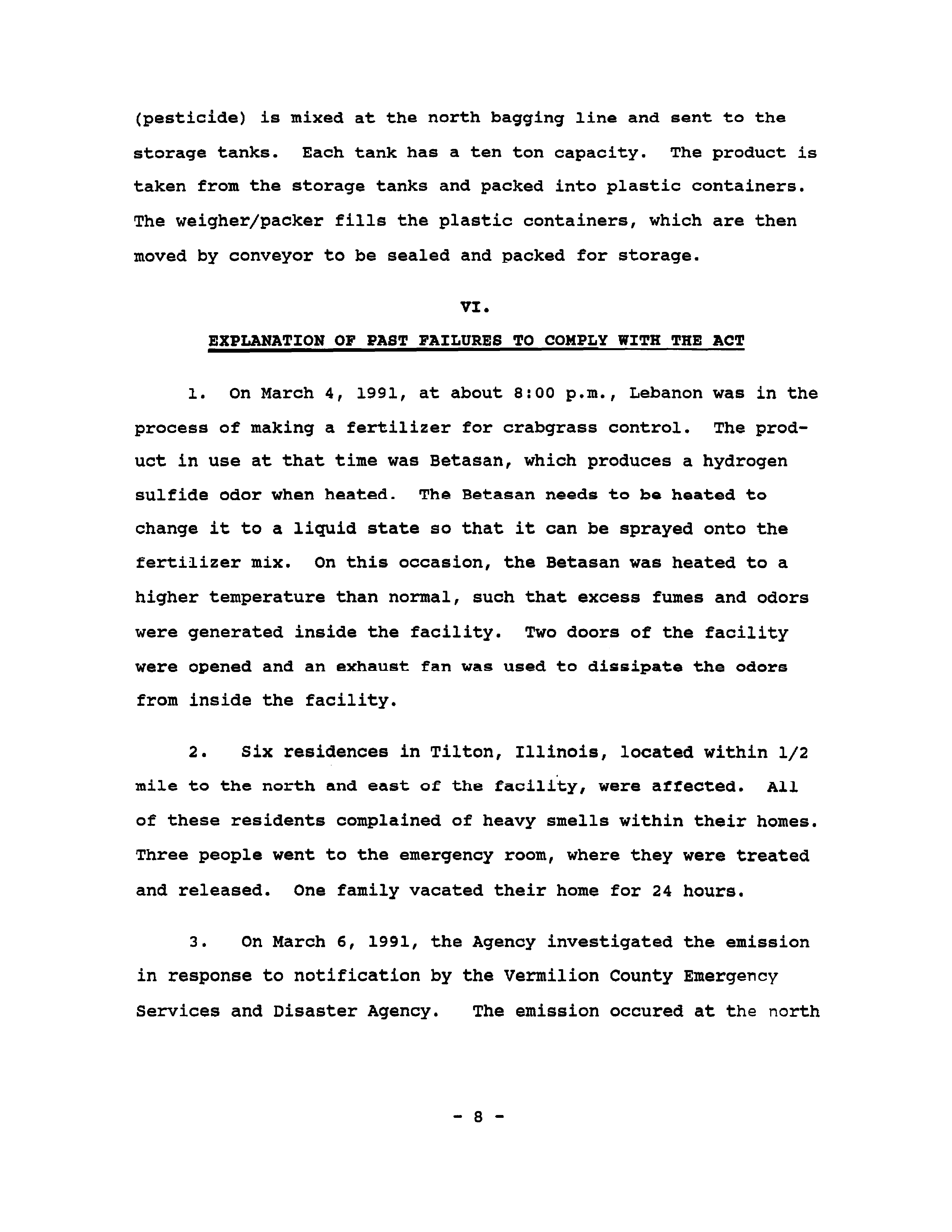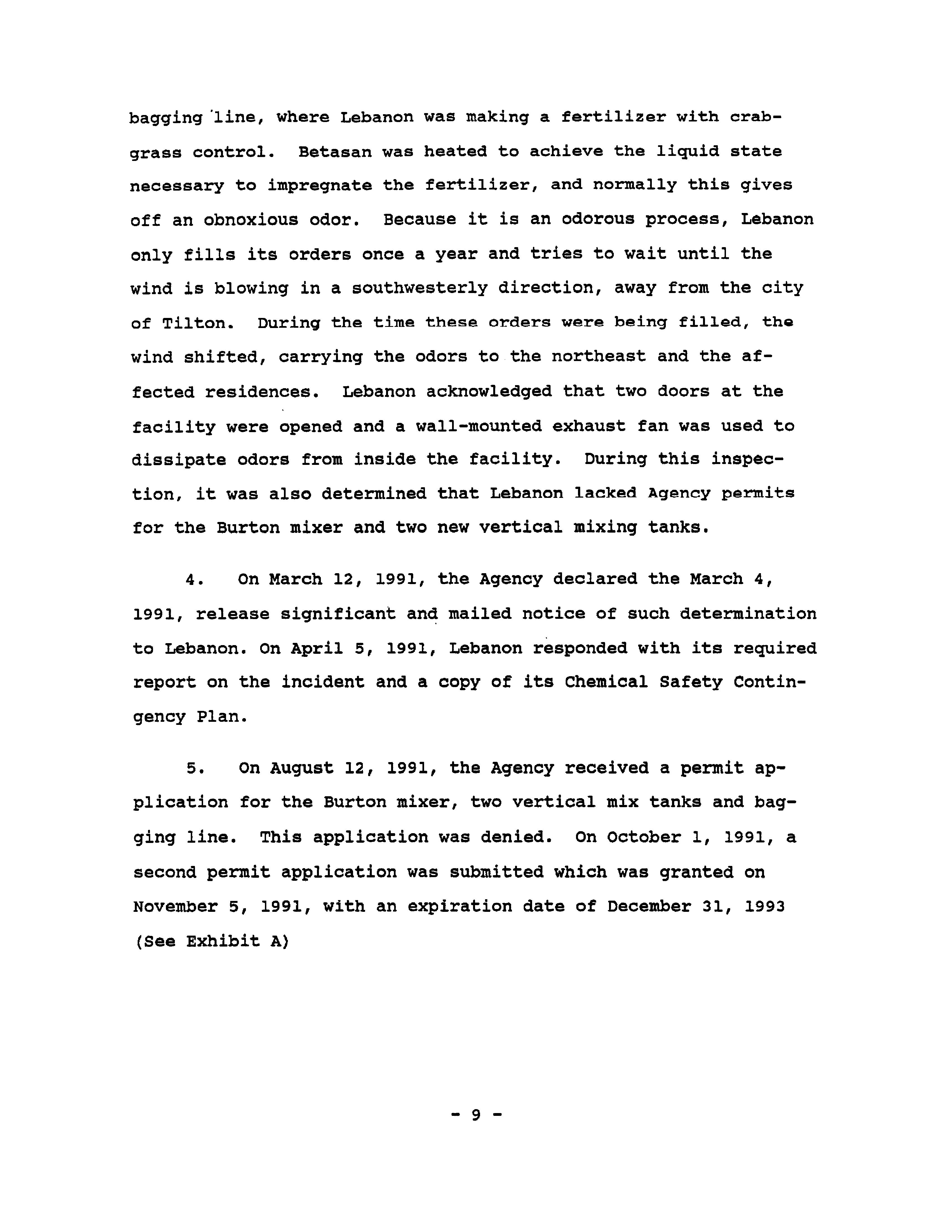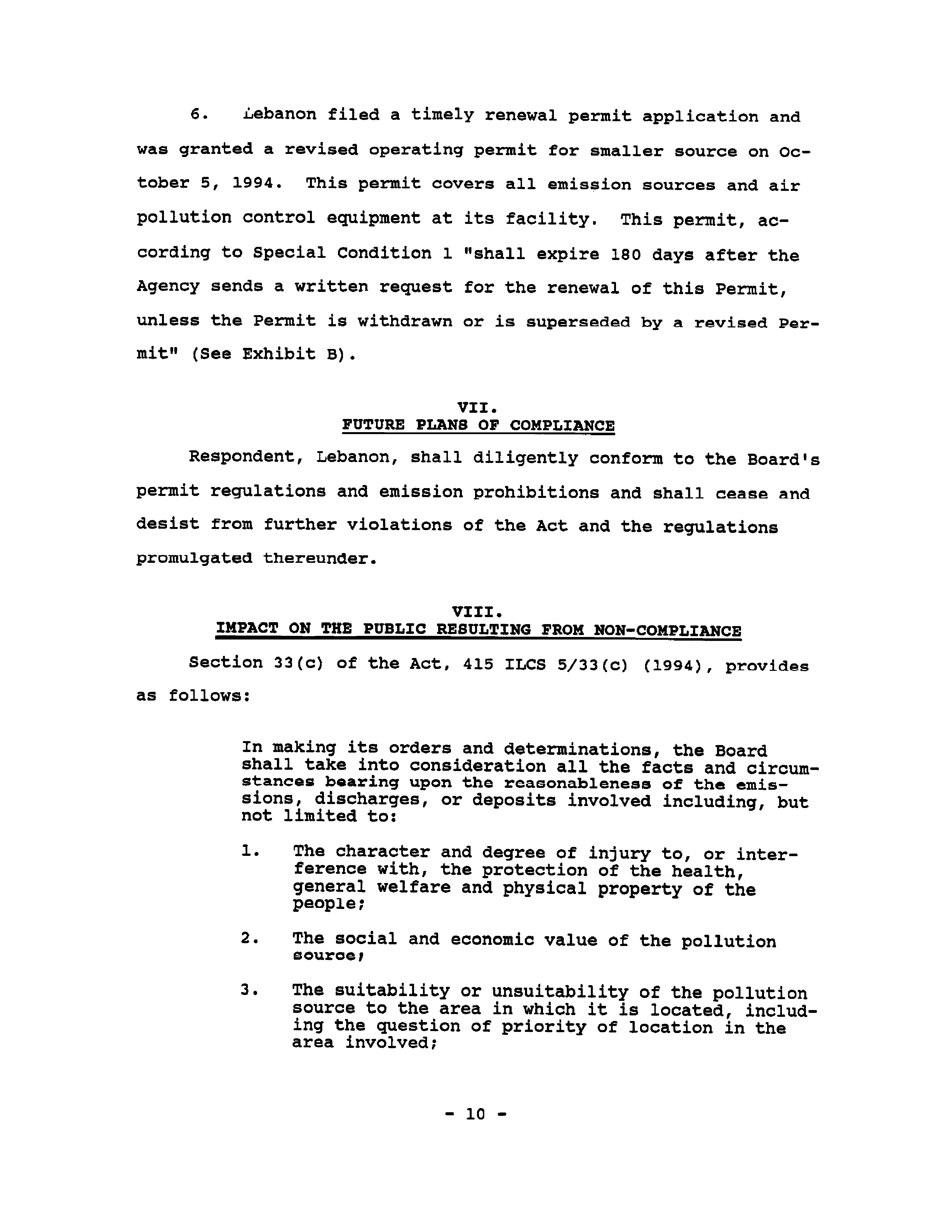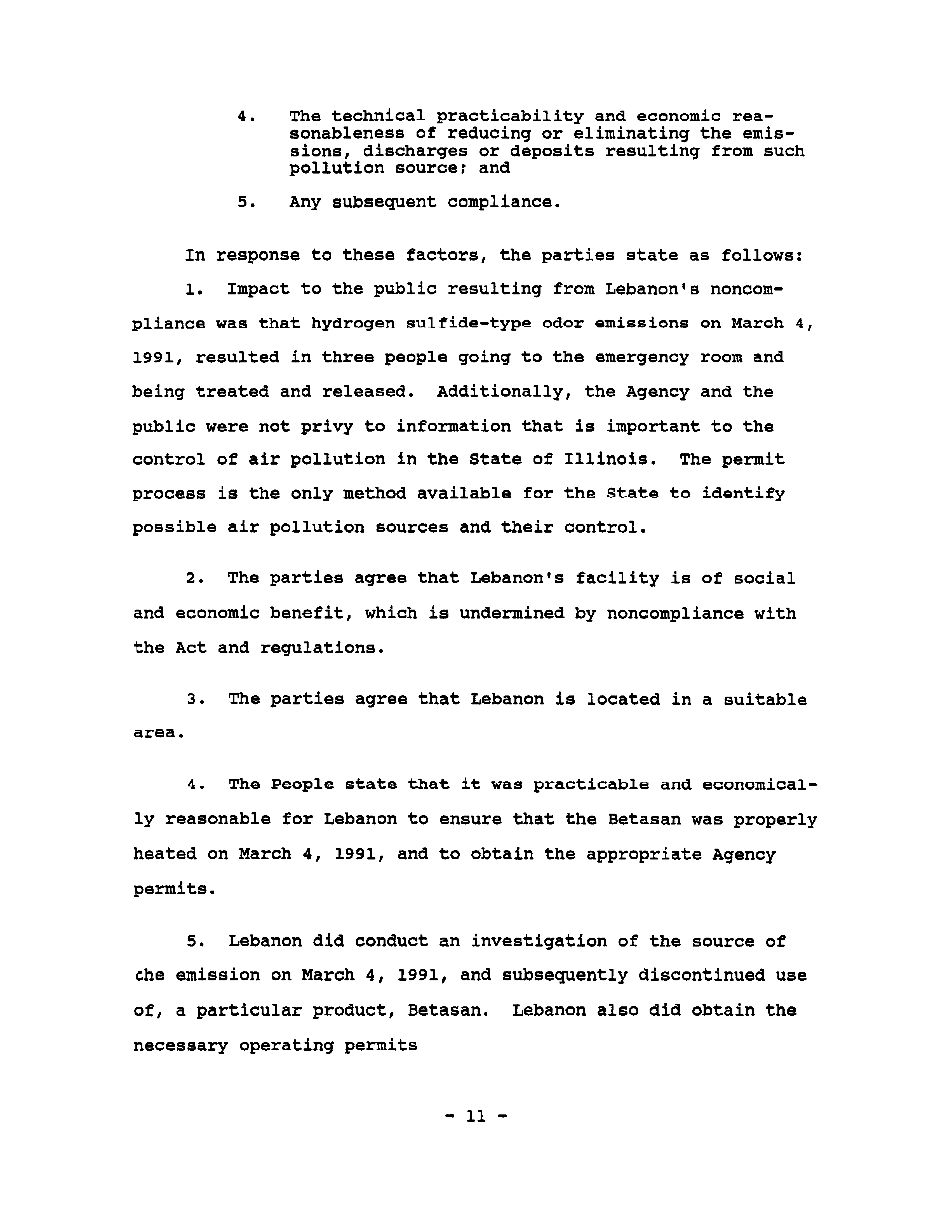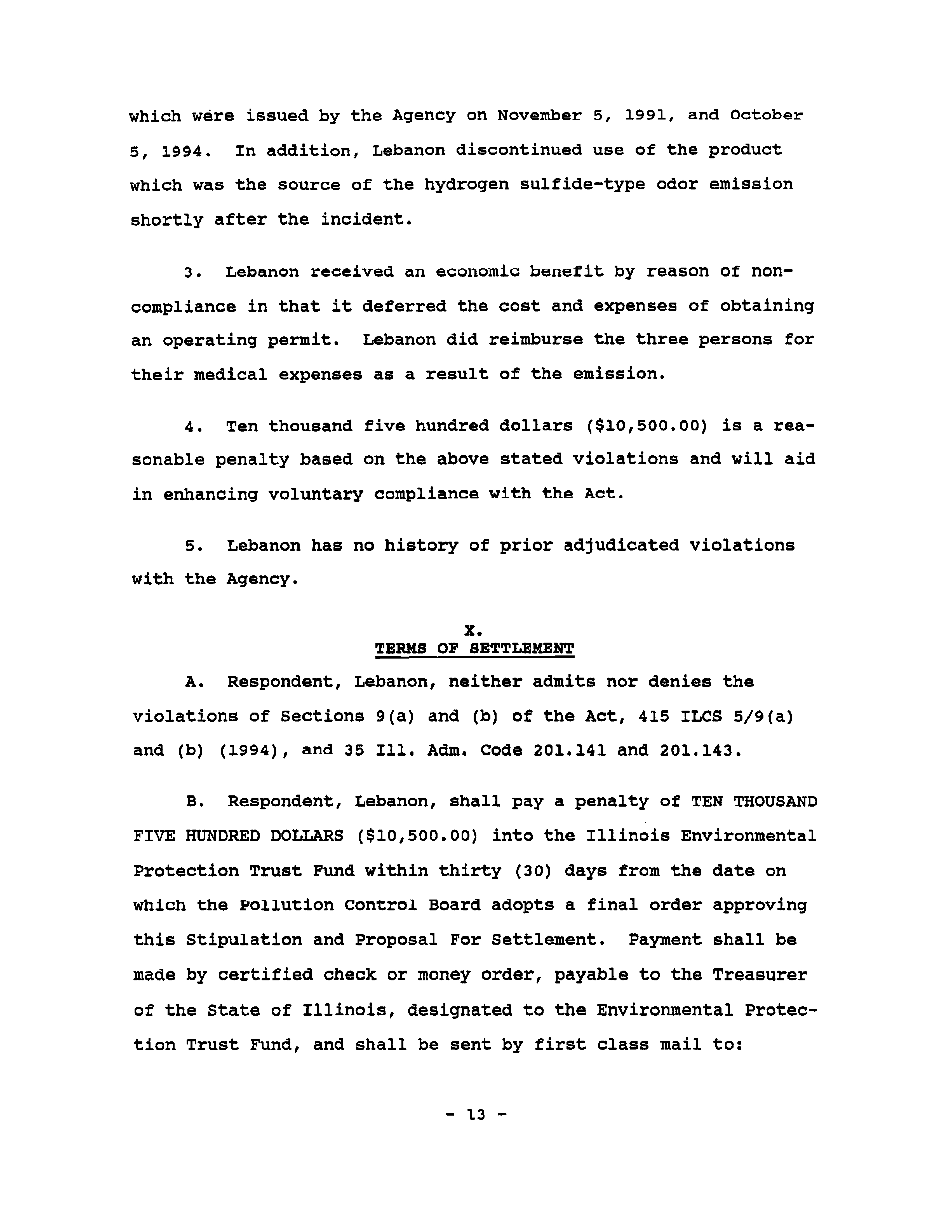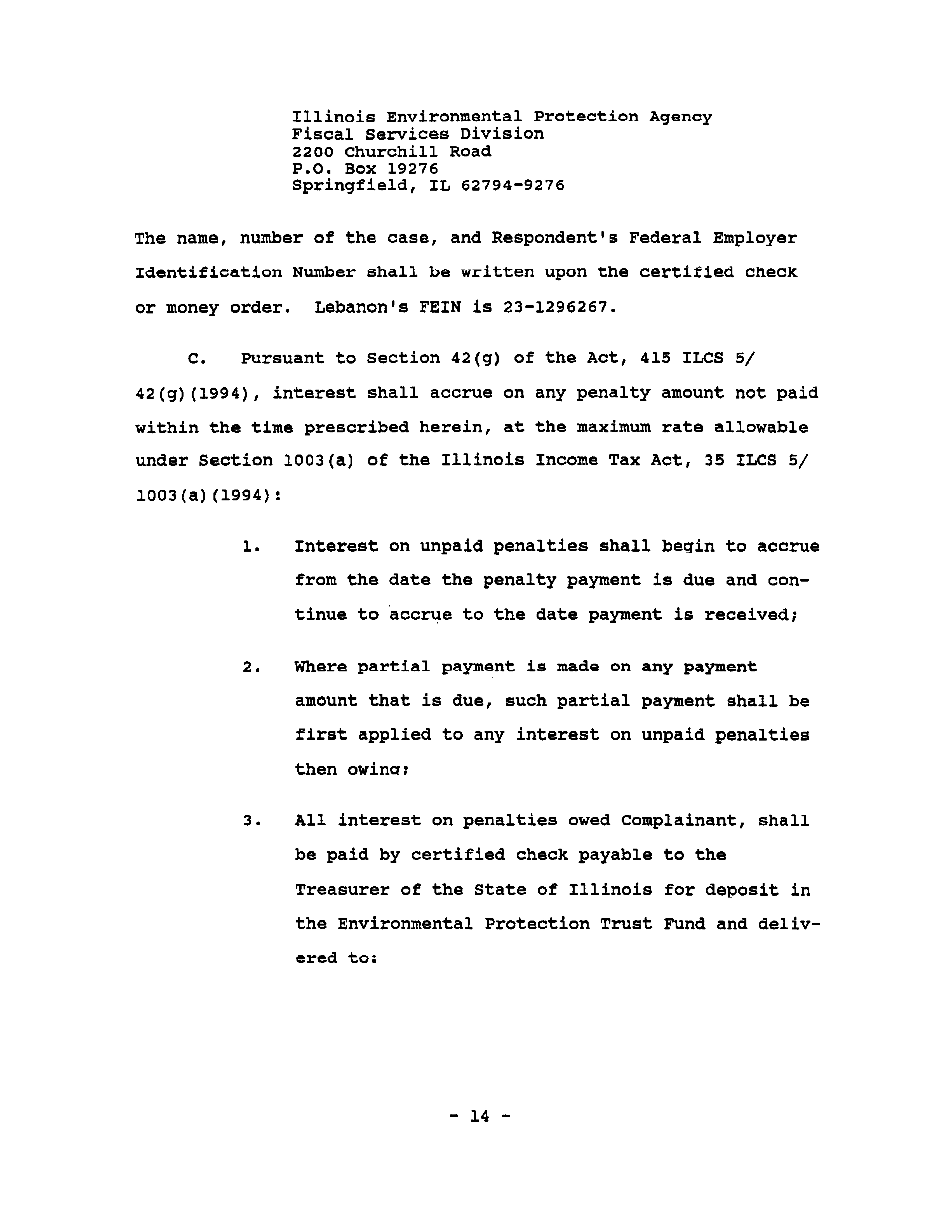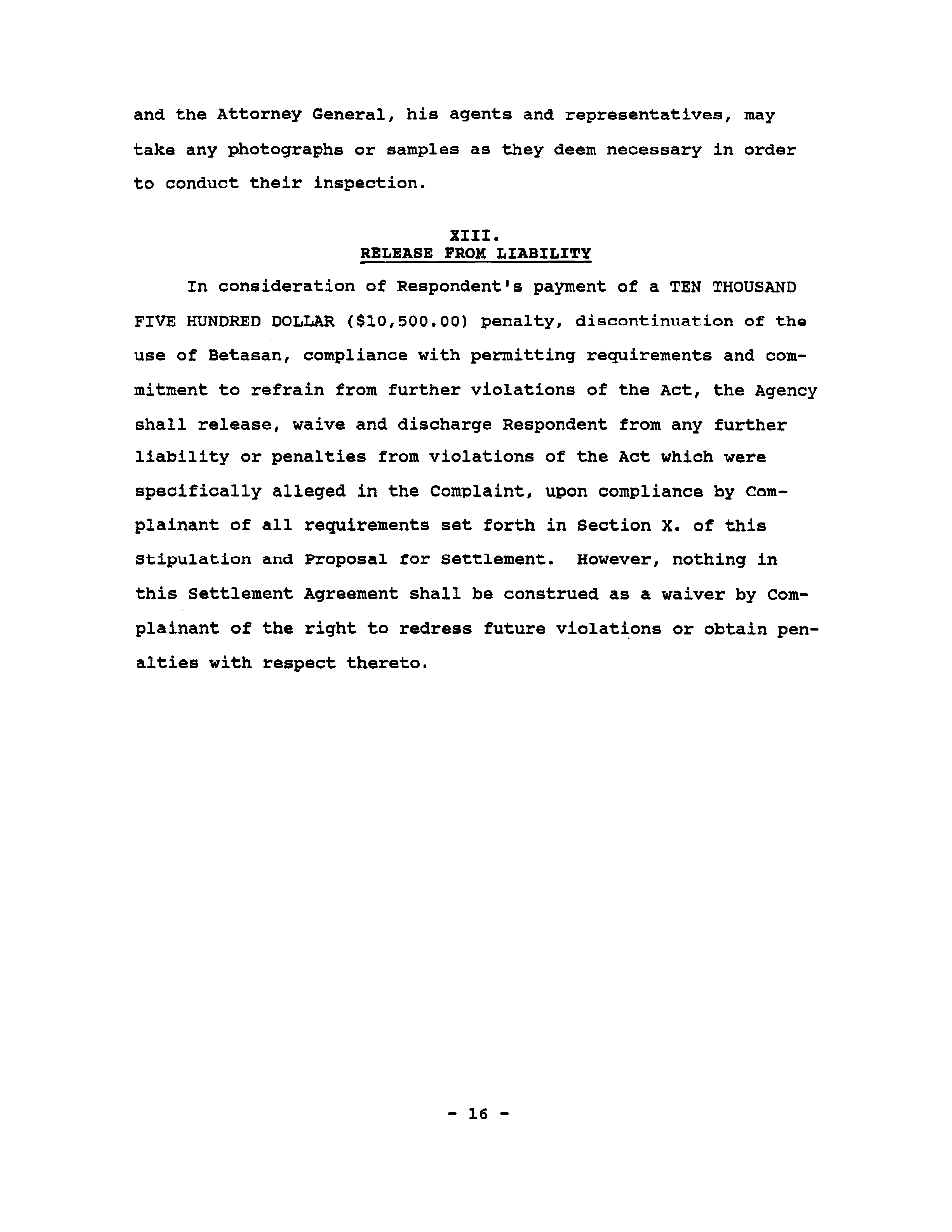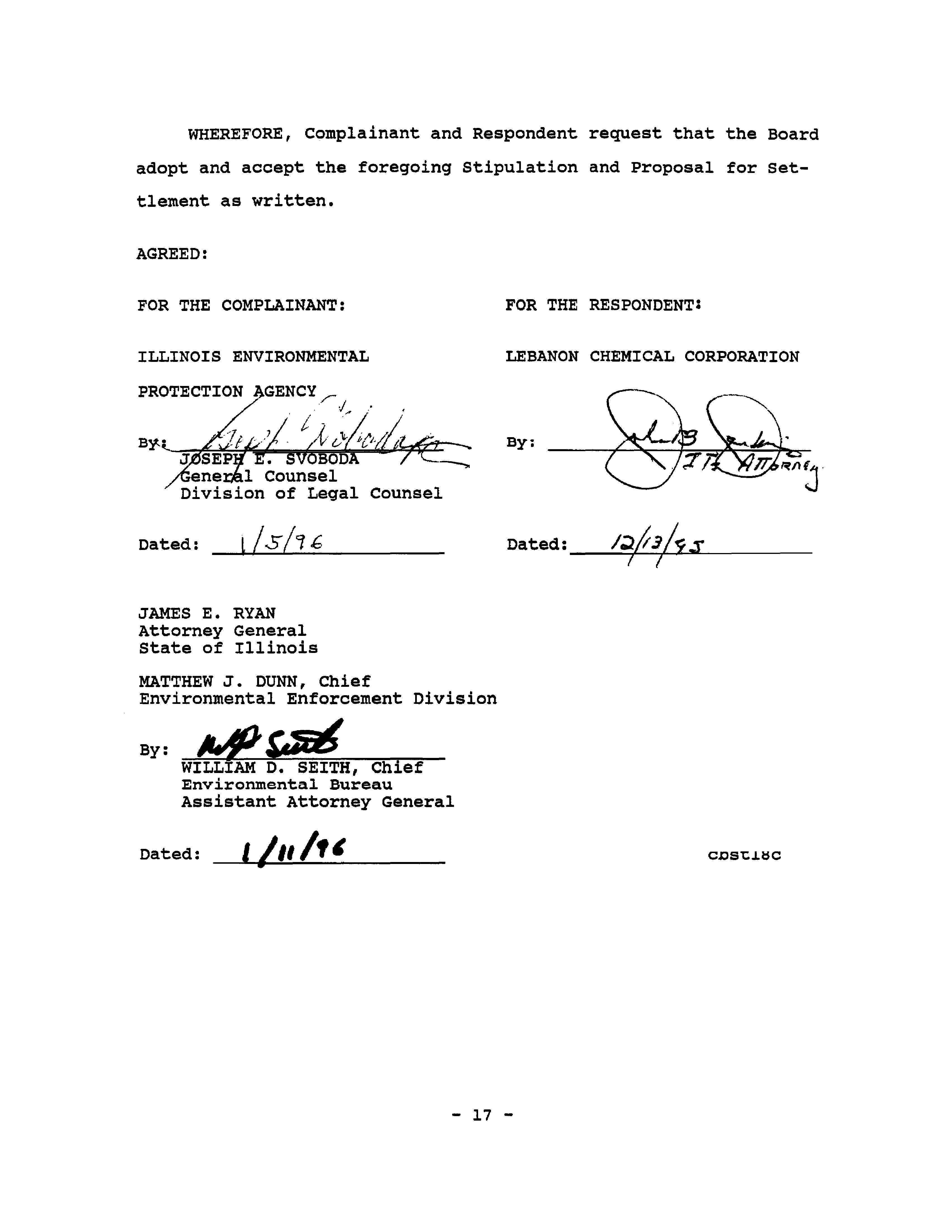ILLINOIS POLLUTION CONTROL BOARD
February
15,
1996
PEOPLE
OF THE STATE OF ILLiNOIS,
)
)
Complainant,
)
)
v.
)
PCB95-124
)
(Enforcement
-
Air)
LEBANON CHEMICAL CORPORATION,
)
a foreign corporation,
)
)
Respondent.
)
ORDER OF THE BOARD (by G.T. Girard):
This matter comes before the Board upon a twa-count cumplairfi. filed April
5,
1995, by
the Attorney General ofthe State ofIllinois,
on behalfofthe Illinois EnvironmentalProtection
Agency and thePeople ofthe State ofIllinois,
against Lebanon Chemical Corporation (Lebanon),
a foreign corporation, located on WestRoss Lane, Danville, Vermilion County, Illinois.
The
complaint alleges that Lebanon hasviolated
Sections 9(a) and 9(b) ofthe Illinois Environmental
Protection Act (Act), (415 ILCS
5/9(a),
5/9(b)) and
35
Ill.
Adm.
Code 201.141
and 201.143 by
causing or allowing the discharge oremission ofhydrogen sulfide vapors and odors into the
environment and by constructing and operating emission sources without the proper permits.
Pursuant to 415 ILCS
5/3
1(a)(2), the parties filed a
joint
motion requesting relieffrom the
Act’s hearing requirement on January
16,
1996.
The Board published a notice ofthe waiver on
January
18,
1996;
no objection to the granting ofthe waiver was received.
Waiver of
hearing
is
hereby granted.
The parties filed a Stipulation and Settlement Agreement on January 16,
1996.
The
Stipulation sets forth facts relating to the nature, operations and circumstances surrounding the
claimed violations. Lebanon neither admits nor denies thealleged violations and agrees to pay a
civil penalty often thousand five hundred dollars ($10,500.00).
The Board
finds
the settlement
agreement acceptable under
35
Ill. Adm. Code
103.180.
This
settlement agreement in no way affects respondent’s responsibility to comply with any federal,
state or local regulations, including but not limited to the Act and the Board’s pollution control
regulations.
This opinion constitutes the Board’s findings
of
fact and conclusions oflaw in this matter.
2
ORDER
1)
The Board hereby accepts the Stipulation and Settlement Agreement executed by
the People ofthe State ofIllinois
and Lebanon Chemical Corporation, a foreign
corporation, located on West Ross Lane, Danville, Vermilion County, illinois.
The
Stipulation and Settlement Agreement are incorporated by reference as though
fully set forth herein.
2)
Lebanon shallpay the sum often thousand five hundred dollars ($10,500.00)
within 30 days ofthe date ofthis Order.
Such payment shall be made by certified
check or money order payable to the Treasurer ofthe State ofIllinois,
designated
to the Environmental Protection Trust Fund, and shall be sent by First Class mail
to:
Illinois Environmental Protection Agency
Fiscal Services Division
2200 Churchill Road
P.O. Box 19276
Springfield,
IL 62794-9276
The certified check or money order shall clearly indicate on its face, Lebanon’s
Federal Employer Identification Number 23-1296267 and that payment is directed
to the Environmental Protection TruätFund.
Any such penalty not paid
within
thetime prescribed shall incur interest at the rate
set
forth in subsection (a) of Section
1003 ofthe Tllinois Income Tax
Act, (35
ILCS .11003), as now or hereafter amended, from the date payment is due until
thedate payment is received.
Interest shallnot accrue during the pendency ofan
appcal during which paymcnt
of
the penalty has been stayed.
3)
Lebanon shall cease and desist from the alleged violations.
IT IS
SO ORDERED.
Section 41 ofthe EnvironmentalProtection Act(415 ILCS
5/41
(1994))
provides
for the
appeal offinal Board orders within 35 days ofthe date ofservice ofthis order.
The Rules ofthe
Supreme Court ofIllinois
establish filing requirements. (See also
35
Ill. Adm. Code
101 .246
“Motions for Reconsideration”.)
I, Dorothy M. Gunn, Clerk ofthe IlIinoi~!oIlution
Control Board, hereby certify that the
above order was adopted on the J5’~dayof
9-4ttt..4.~
,
1996, by a vote of
7-c.
j
4
7?O~UC2~
2kt
/?&~ø1
‘Dorothy M. Guufj, Clerk
‘
Illinois Pollutio4vtontrol Board
RECEIVED
CLERKS OFFICE
BEFORE THE ILLINOIS POLLUTION CONTROL BOZ4D
JAN
16
1996
I
STATE OF ILLINOIS
PEOPLE OF THE STATE OF ILLINOIS,
)
~9!LUTION
CONTROL
BOARD
)
Complainant
)
v.
)
PCB
95—124
)
(Enforcement)
LEBANON
CHEMICAL
CORPORATION,
)
a foreign corporation,
)
)
Respondent.
STIPULATION AND PROPOSAL FOR SETTLEMENT
Complainant, PEOPLE OF THE STATE OF ILLINOIS, by their at-
torney,
JAMES E. RYAN,
Attorney General of the State of Illinois,
at the recauest of the Illinois Environmental Protection Agency
(“Agency”),
and
Respondent,
LEBANON
CHEMICAL
CORPORATION,
by
it~
attorney,
JOHN
B.
JENKINS
of
GUNN
&
HICKMAN,
P.C.,
do
hereby
sub-
mit
this
Stipulation
and
Proposal
for
Settlement.
The
parties
agree
that
the
statement
of
facts
contained
herein
represents
a
fair summary of the evidence and testimony which would be intro-
duced by the parties if a full hearing were held.
The parties
have
decided
to
forego
a
determination
of
whether
Respondent
is
liable
for
the
alleged
violations
in
the
interest
of
avoiding
the
expense and uncertainty of litigation.
The parties further
stipulate that this statement of facts is made and agreed upon
for purposes of settlement only, and that neither the fact that a
party has entered into this Stipulation, nor any of the facts
stipulated herein,
shall be introduced into evidence in this or
any other proceeding except to enforce the terms hereof by the
—
I—
parties to this agreement.
Notwithstanding the previous sen-
tence, this Stipulation and Proposal for Settlement and any Pol-
lution Control Board
(“Board”) Order accepting same may be used
in any future enforcement action as evidence of a past adjudica-
tion of violation of the Act for purposes of Section 42(h)
of the
Illinois
Environmental
Protection
Act
(“Act”),
415
ILCS
5/42(h)
(1994).
The agreement shall be null and void unless the Board
approves and disposes of this matter on each and every one of the
tens and conditions of the settlement set forth herein.
I.
JURISDICTION
The Board
has
jurisdiction
of
the
subject matter herein and
of
the
parties
consenting hereto pursuant to the Illinois En-
vironmental Protection Act
(“Act”), 415 ILCS 5/1 et
seq
(1994).
II.
AUTHORIZATION
The undersigned representatives for each party certify that
they are fully authorized by the party whom they represent to
enter into the tens and conditions of this Stipulation and Pro-
posal For Settlement, and to legally bind them to it.
III.
APPLICABILITY
This Stipulation and Proposal For Settlement shall apply to,
and be binding upon, the Complainant and Respondent,
as well as,
the successors and assignees of each and any officer, director,
agent, employee or servant of Respondent.
The Respondent shall
not raise as a defense, to any enforcement action taken pursuant
—2—
to this’Settlement, the failure of its agents, servants or
em-
ployees
to take such action as shall be required to comply with
the provisions of this Settlement.
IV.
STATEMENT OF FACTS
1.
The Agency is an administrative agency established in
the
executive branch of the State government
by
Section
4
of
the
Act,
415
ILCS
5/4
(1994),
and
charged,
inter alia,
with
the
duty
of enforcing the Act.
2.
Respondent,
LEBANON CHEMICAL
CORPORATION
(“Lebanon”),
is
a foreign corporation doing business in Illinois.
At all times
relevant
to
the
Complaint,
Lebanon has owned and operated a
facility located on West Ross Lane,
Danvifle, Vermilion County,
Illinois.
At this facility, Lebanon formulates herbicides and
operates a lawn and garden fertilizer mixing and blending
process.
3.
Sections 3.02 and 3.06 of the Act,
415 ILCS 5/3.02 and
3.06
(1994), provide the following definitions:
“CONTAMINANT” is any solid, liquid or gaseous matter,
any odor, or any form of energy,
from whatever source.
“AIR POLLUTION” is the presence in the atmosphere of
one or more contaminants in sufficient quantities and
of such characteristics, and duration as to be injurious
to human, plant, or animal life,
to health, or to prop-
erty,
or to unreasonably interfere with the enjoyment
of life or property.
Section 9(a)
of the Act, 415 ILCS 5/9(a)
(1994),
pro—
4.
vides as follows:
No
person shall:
—3—
a.
Cause
or
threaten
or
allow
the discharge or
emission
of
any contaminant
into
the
environ-
ment
in
any
State
so
as
to
cause
or
tend
to
cause
air
pollution
in
Illinois,
either
alone
or
in
combination
with
contaminants
from
other
sources, or so as to violate regulations or
standards adopted by the Board under this Act.
5.
Section 201.i41 of the Board’s Air Pollution Regula-
tions,
35
Ill.
Adm.
Code 201.141, provides as follows:
Section
201.141
Prohibition
of
Air
Pollution
No person shall cause or threaten or allow the discharge
or emission of any contaminant into the environment in
any State so as, either alone or in combination with
contaminants from other sources,
tO cause or tend
to
cause air pollution in Illinois, or so as to violate the
provisions of this Chapter, or so as to prevent the at-
tainment or maintenance of any applicable ambient air
quality standard.
6.
On or about March
4,
1991, Lebanon caused and/or al—
lowed the discharge or emission of a contaminant(s) into the en-
vironment of the State of Ilinois, to wit: hydrogen sulfide-type
odors,
so
as
to
cause,
or tend to cause air pollution in
Ii—
linois.
As
a result of this emission, three nearby residents
went
to
the
emergency
room and were treated and released.
7.
Lebanon investigated the cause of this emission.
It
was determined that a product called Betasan was being heated for
spraying onto a fertilizer for crabgrass control.
The Betasan
gives off hydrogen sulfide-type odors when heated.
On March
4,
1991, the Betasan was heated beyond the usual temperature,
resulting
in severe odors.
Doors
at
the
facility
were
opened
and
an exhaust fan was used to dissipate the odors from within the
facility to the atmosphere.
—4-.
8.
Section
201.102
of
the
Board’s
Air
Pollution
Regula—
tions,
35
Ill.
Adm.
Code
201.102,
provides,
in pertinent part,
the
following
definitions:
“Emission Source”:
any equipment or facility of a type
capable of emitting specified air contaminants to the
atmosphere.
“New Emission Source”:
any emission source, the con-
struction or modification of which
th
commenced
on
or
after
April
14,
1972.
“Air Contaminant”:
any solid, liquid or gaseous mat-
ter, any odor or any form of energy, that is capable of
being released
into the atmosphere from an emission
source.
“Specified Air Contaminant”:
any air contaminant as to
which this Subtitle contains emission standards or
other specific limitations.
9.
Section 9(b) of the Act, 415 ILCS 5/9(b)
(1994), pro-
vides as
follows;
No
person
shall:
b.
Construct,
install,
or
operate
any
equipment,
facility, vehicle, vessel, or aircraft
capable
of
causing or contributing to air pollution or desig-
ned to prevent air pollution of any type desig-
nated by Board regulations, without a permit gran-
ted by the
Agency,
or
in
violation
of
any condi-
tions imposed by such permit.
10.
Section 201.143 of the Board’s Air Pollution regula-
tions,
35 Ill. Adm. Code 201.143, provides as follows:
section 201.143
Operating
Permits
for
New Sources
No person shall cause
or
allow
the
operation
of
any
new
emission source or new
air pollution control equipment
of a
typ.
for
which
a construction permit is
required
by Section 201.142 without first obtaining an operating
permit from the Agency, except by such testing opera-
tions as may be authorized by the construction permit.
Applications
for
operating
permits
shall
be
made
at
such times and contain such information
(in addition to
—5
the
information
required
by Section 201.157) as shall
be specified
by
the
construction
permit.
11.
At its facility, Lebanon operates a Burton double drum
mixer and two vertical mixing tanks.
This equipment emits,
or is
capable of emitting, a specified air contaminant,
to wit: par-
tioulate matter.
The equipment
was constructed after April
14,
1972,
and
constitutes
new
emission sources, as that term is de-
fined in 35 Ill.
Adm.
Code 201.102,
and requires an Agency
operating
permit.
12.
From at least March
6,
1991, until November 5,
1991,
Lebanon operated all of the equipment listed in Paragraph 11 at
its facility, without the required Agency operating permit.
13.
On November 5,
1991, the Agency issued an operating
permit for the equipment listed in Paragraph 11, with an expira-
tion date
of December 31,
1993.
On October 5,
1994, the Agency
issued a revised operating permit for smaller source, which in-
cluded the same equipment.
The expiration date for this permit
is “180 days after the Agency sends a written request for the
renewal of this Permit, unless the Permit is withdrawn or is
superseded by a revised Permit”.
V.
NATURE
OF RESPONDENT’S OPERATIONS
AND
CONTROL
EQUIPMENT
Lebanon
produces
lawn
and
turf
products,
including
impreg-
nated fertilizers for golf courses and lawn and garden centers.
The process consists of bulk loading and unloading, the north
bagging line, the south bagging line, and the small package bag-
ging line.
—6—
Th~
bulk loading process consists of a loading spout that
can
move vertically and horizontally to load material into a
truck
or
rail
car.
The
bulk
unloading
process
consists
of
an
open receiving pit, where material
is
stored
for
use
in
fer-
tilizer
or
pesticides.
Materials
stored
in
tbi~ process
are
potash,
urea
and
minerals.
Pesticides are dumped into a dump
station
which
breaks
up
any
large
lumps
and
sends
the
pesticide
to
holding
vats.
These vats are tanks which have hot water tubes
circulating
to
heat
the
materials.
The north bagging line consists of three pesticide holding!
mixing vats,
two
Continental
mixers
with charge hoppers, an In-
glett
&
Corley
weigh
hopper/bagger,
bag
sealer and miscellaneous
conveyors.
The vats, mixers and weigh
hopper/bagger
are
con-
trolled by a Wheel-a-brator baghouse.
Bulk material is placed in
the mixers and weighed.
Pesticide is weighed and sprayed into
the
mixers
to
impregnate
the
material.
The
impregnated materials
are
sent
to
the
weigh
hopper/bagger
to
be
bagged.
The bags are
sealed and are stored for shipment.
The
south
bagging
line
consists
of
a
cluster
hopper,
Burton
mixer,
Inglett & Corley weigh hopper/bagger, bag sealer and mis-
cellaneous conveyors.
Bulk material is placed in the Burton
mixer to make fertilizer and is then weighed.
It is mixed and
sent
tO
tfle weign hopper/bagger.
Bags are then sealed and stored
for shipment.
The
small
package
bagging line consists of four bulk storage
tanks and an Express scale weigher/packer.
The bulk material
—7—
(pesticide)
is mixed at the north bagging line
and sent to the
storage tanks.
Each tank has a ten ton capacity.
The product is
taken from the storage tanks and packed into plastic containers.
The weigher/packer fills the plastic containers, which are then
moved by conveyor to be sealed and packed for storage.
VI.
EXPLANATION
OF
PAST
FAILURES
TO
COMPLY WITH THE ACT
1.
On March
4,
1991,
at about 8:00 p.m., Lebanon was in the
process of making a fertilizer for crabgrass control.
The prod-
uct in use at that time was Betasan, which produces a hydrogen
sulfide odor when heated.
The Betasan needs
to be heated to
change
it to a liquid state so that it can be sprayed onto the
fertilizer mix.
On this occasion, the Betasan was heated to a
higher temperature than normal, such that excess fumes and odors
were generated inside the facility.
Two doors of the facility
were opened and an exhaust fan was used to dissipate the odors
from inside the facility.
2.
Six residences in Tilton, Illinois, located within 1/2
mile to the north and east of the facility, were affected.
AL.
of these residents complained of heavy smells within their homes.
Three people went to the emergency room, where they were treated
and released.
One family vacated their home for 24 hours.
3.
On March
6,
1991,
the Agency investigated the emission
in response to notification by the Vermilion County Emergency
Services and Disaster Agency.
The emission occured at the north
—8—
bagging line, where Lebanon was making a fertilizer with crab-
grass control.
Betasan was heated to achieve the liquid state
necessary to impregnate the fertilizer, and normally this gives
off
an
obnoxious odor.
Because
it
is
an
odorous
process, Lebanon
only
fills
its
orders
once
a
year
and
tries
to
wait
until
the
wind
is
blowing
in
a
southwesterly
direction,
away
from
the
city
of
Tilton.
During
the
time
these
orders
were
being
filled,
the
wind shifted,
carrying
the
odors
to
the
northeast
and
the
af-
fected residences.
Lebanon acknowledged that two doors at the
facility were opened and a wall-mounted exhaust fan was used to
dissipate
odors
from
inside
the
facility.
During this inspec-
tion,
it
was also determined that Lebanon lacked Agency permits
for
the
Burton
mixer
and
two
new vertical mixing tanks.
4.
On
March
12,
1991,
the Agency declared the March
4,
1991,
release significant and mailed
notice
of
such
determination
to
Lebanon.
On
April
5,
1991,
Lebanon
responded
with
its
required
report on the incident and a copy of its Chemical Safety
Contin-
gency Plan.
5.
On August 12,
1991, the Agency received a permit ap-
plication for the Burton mixer, two vertical mix tanks and bag-
ging line.
This application was denied.
On October 1,
1991,
a
second permit application was submitted which was granted on
November 5,
1991, with an expiration date of December 31, 1993
(See Exhibit A)
—9—
6.
Lebanon filed a timely renewal permit application and
was
granted
a
revised
operating
permit for smaller source on Oc-
tober
5,
1994.
This
permit
covers all emission sources and air
pollution control equipment at its facility.
This permit, ac-
cording to Special Condition 1 “shall expire 180 days after the
Agency sends a written request for the renewal of this Permit,
unless
the
Permit
is
withdrawn
or
is
superseded
by
a revised Per-
mit”
(See Exhibit B).
VII.
FUTURE PLANS OF COMPLIANCE
Respondent, Lebanon, shall diligently conform to the Board’s
permit regulations and emission prohibitions and shall cease
and
desist
from further violations of the Act and the regulations
promulgated thereunder.
VIII.
IMPACT ON THE PUBLIC RESULTING FROM NON-COMPLIANCE
Section
33(c)
of
the
Act,
415
ILCS
5/33(c)
(1994),
provides
as follows:
In making its orders and determinations,
the Board
shall take into consideration all the
facts and circum-
stances bearing upon the reasonableness of the emis-
sions,
discharges,
or deposits involved including, but
not limited to:
1.
The
character
and
degree
of
injury
to,
or
inter-
ference with, the protection of the health,
general welfare and physical property of the
people;
2.
The social and economic value of the pollution
eouroe~
3.
The suitability or unsuitability of the pollution
source to the area in which
it is located, includ-
ing the question of priority of location in the
area involved;
—
10
—
4.
The technical practicability and economic rea-
sonableness of reducing or eliminating the emis-
sions, discharges or deposits resulting from such
pollution source; and
5.
Any subsequent compliance.
In
response
to
these
factors,
the
parties
state as follows:
1.
Impact to the public resulting
from
Lebanon’s
noncom-
pliance was that hydrogen sulfide—type odor emissions on March
4,
1991, resulted in three people going to the emergency room and
being treated and released.
Additionally, the Agency and the
public were not privy to information that is important to the
control of air pollution in the State of Illinois.
The permit
process
is the only method available for the state to identify
possible air pollution sources and their control.
2.
The parties agree that Lebanon’s facility is of social
and economic benefit, which is undermined by noncompliance with
the Act and regulations.
3.
The parties agree that Lebanon is located in a suitable
area.
4.
The
People
state
that it was practicable and economical-
ly reasonable for Lebanon to ensure that the Betasan was properly
heated
on
March
4,
1991,
and
to
obtain
the
appropriate
Agency
permits.
5.
Lebanon did conduct an investigation of the source of
che
emission
on
March
4,
1991,
and
subsequently
discontinued
use
of,
a particular product, Betasan.
Lebanon also did obtain the
necessary operating permits
—
11
—
IX.
CONSIDERATION OP SECTION 42(h)
FACTORS
Section
42(h)
of
the
Act,
415 ILCS 5/42(h) (1994), provides
as
follows:
In
determining
the
appropriate
civil
penalty
to
ze
im-
posed under subdivisions
(a),
(b)(l),
(b)(2),
or
(b)(3)
of this Section,
the Board is authorized to consider
any matters of record in mitigation or aggravation of
penalty, including but not limited to the following
factors:
1.
the duration and gravity of the violation;
2.
the presence or absence of due diligence on the
part of the violator in attempting to comply with
requirements of this Act and regulations there-
under or to secure relief therefrom as provided by
this Act;
3.
any economic benefits accrued by the violator be-’
cause of delay in compliance with requirements;
4.
the amount of monetary penalty which will serve to
deter further violations by the violator and to
otherwise aid in enhancing voluntary compliance
with this Act by the violator and other persons
similarly subject to the Act; and
5.
the
number, proximity in time, and gravity of pre-
viously adjudicated violations of this Act by the
violator.
In response to these factors, the parties state as follows:
1.
Lebanon’s hydrogen sulfide—type odor emissions lasted
less than 6 hours, but did cause three people to seek emergency
room treatment.
Lebanon operated three pieces of equipment with-
out a permit at its facility from at least March
6,
1991, until
November
5,
1991.
2.
Lebanon did subsequently comply with air pollution con-
trol requirements by obtaining the necessary operating permits,
—
12
which
were
issued
by
the
Agency
on
November
5,
1991, and October
5,
1994.
In addition, Lebanon discontinued use of the product
which was the source of the hydrogen sulfide—type odor emission
shortly after the incident.
3.
Lebanon received an economic benefit by reason or non-
compliance in that it deferred the cost and
expenses of obtaining
an operating permit.
Lebanon did reimburse the three persons for
their medical expenses as a result of the emission.
4.
Ten thousand five hundred dollars
($10,500.00)
is a rea-
sonable penalty based on the above stated violations and will aid
in enhancing voluntary compliance with the Act.
5.
Lebanon
has
no
history
of
prior
adjudicated
violations
with
the
Agency.
K.
TERMS
OP
SETTLEMENT
A.
Respondent,
Lebanon, neither admits nor denies the
violations of Sections 9(a)
and
(b) of the Act,
415 ILCS 5/9(a)
and
(b)
(1994), and 35 Iii.
Adm.
Code 201.141 and 201.143.
B.
Respondent,
Lebanon,
shall pay a penalty of TEN THOUSAND
FIVE
HUNDRED DOLLARS
($10,500.00)
into the Illinois Environmental
Protection Trust Fund within thirty
(30) days from the date on
which the Pollution control Board adopts a final order approving
this Stipulation and Proposal For Settlement.
Payment shall be
made by certified check or money order, payable to the Treasurer
of the State of Illinois, designated to the Environmental Protec-
tion Trust Fund,
and shall be sent by first class mail to:
—
13
—
Illinois Environmental Protection Agency
Fiscal Services Division
2200 Churchill Road
P.O. Box 19276
Springfield,
IL
62794—9276
The name, number of the case, and Respondent’s Federal Employer
identification Number sh~1lbe written upon the certified check
or money order.
Lebanon’s FEIN is 23-1296267.
C.
Pursuant to Section 42(g)
of the Act, 415
ILCS 5/
42 (g) (1994),
interest shall accrue on any penalty amount not paid
within the time prescribed herein, at the maximum rate allowable
under Section 1003(a) of the Illinois Income Tax Act,
35 ILCS 5/
1003 (a) (1994) ~
1.
Interest on unpaid penalties shall begin to accrue
from the date the penalty payment is due and con-
tinue to accrue to the date payment is received;
2.
Where
partial payment is made on any payment
amount that is due, such partial payment shall be
first
applied
to
any
interest
on
unpaid
penalties
then owina;
3.
All
interest
on penalties owed Complainant, shall
be paid
by
certified check payable to the
Treasurer of the State of Illinois for deposit in
the Environmental Protection
Trust
Fund and deliv-
ered to;
—
14
—
Illinois Environmental Protection
Agency
Fiscal Services Division
2200 Churchill Road
P.O. Box 19276
Springfield, IL 62794—9276
The name and number of the case and Lebanon’s Federal Employer
Identification Number
(“FEIN”)
shall appear on the face of the
check.
Lebanon’s FEIN is 23—1296267.
D.
Respondent,
Lebanon,
shall cease and desist from further
violations of the Act and regulations promulgated thereunder-
E.
Respondent,
Lebanon,
shall cease and desist from further
violations of Sections 9(a) and
(b)
of
the
Act, 415 ILCS 5/9(a)
and (b)(l994), and 35 Ill. Adm. Code 201.141 and 201.143.
XI.
COMPLIANCE WITH OTHER LAWS AND REGULATIONS
This settlement agreement in no way affects Respondent’s
responsibility to comply with any federal, state or local
regul
tions, including but not limited to, the Act,
415 ILCS 5/1 et
seq
(1994), and the Illinois Pollution Control Board’s Air Pollution
Control regulations.
XII.
RIGHT OF
ENTRY
In addition to any other
authority,
the
Agency,
its
em-
ployees an~representatives, and the Illinois Attorney General,
his agents and representatives,
shall have right of entry to
Lebanon’s facility at all reasonable times,
for the purposes of
conducting inspections.
In conducting any inspection of Leba-
non’s facility, the Agency,
its employees and representatives,
—
15
—
and the Attorney General, his agents and representatives, may
take any photographs or samples as they deem necessary in order
to conduct their inspection.
XIII.
RELEASE PROM LIABILITY
In
consideration
of
Respondent’s
payment
of
a
TEN THOUSAND
FIVE HUNDRED DOLLAR ($10,500.00)
penalty,
discontinuation of
the
use of Betasan, compliance
with permitting requirements and com-
mitment to refrain from further violations of the Act, the Agency
shall release, waive and discharge Respondent from any further
liability or penalties from violations of the Act which were
specifically alleged in the Complaint, upon compliance by Com-
plainant of all requirements set forth in Section X. of this
Stipulation and Proposal for Settlement.
However, nothing in
this Settlement Agreement shall be construed as a waiver by Com-
plainant of the right to redress future violations or obtain pen-
alties with respect thereto.
—
16
—
WHEREFORE,
Complainant and Respondent request that the Board
adopt and accept the foregoing Stipulation and Proposal for Set-
tlement as written.
AGREED:
FOR
THE
COMPLAINANT:
ILLINOIS
ENVIRONMENTAL
PROTECTION
AGENCY
Bfl
JftSEP/~.
SVOBODA
Aenet*1
Counsel
Division of Legal Counsel
Dated:
Is/i
£
FOR THE RESPONDENT:
LEBANON
CHEMICAL
CORPORATION
By
Dated:
S
/
/•
JAMES
E
•
RYAN
Attorney General
State of Illinois
MATTHEW J.
DUNN,
Chief
Environmental Enforcement Division
By:
WILLIAM D.
SEITH, Ch ef
Environmental Bureau
Assistant Attorney General
Dated:
I/UI?’
cosciac
—
17
—
